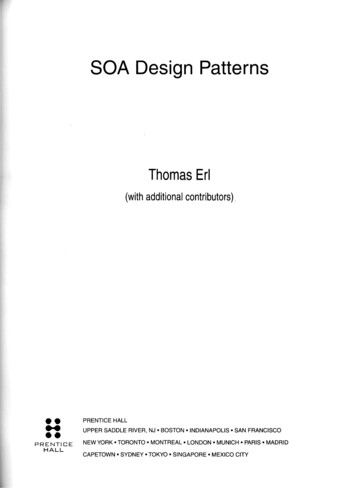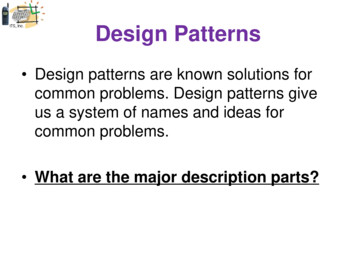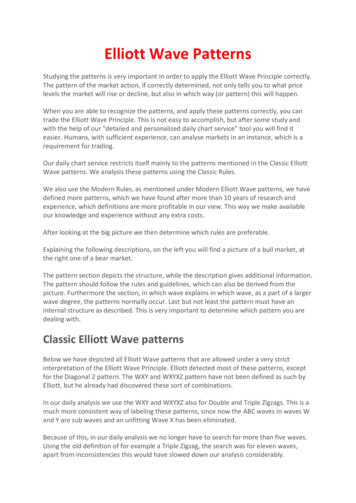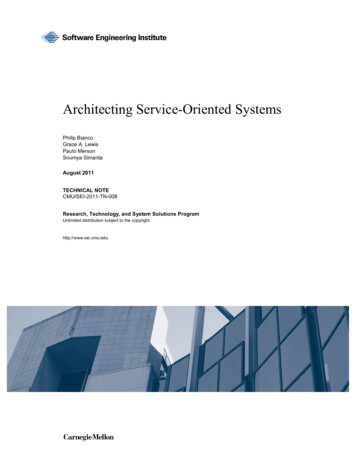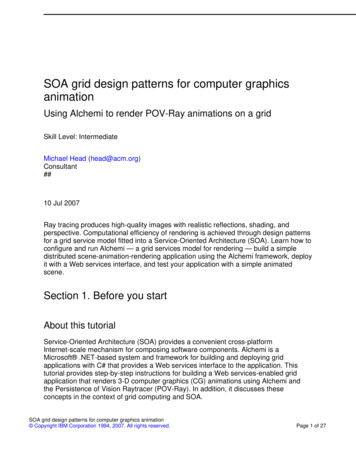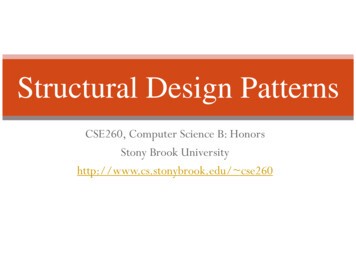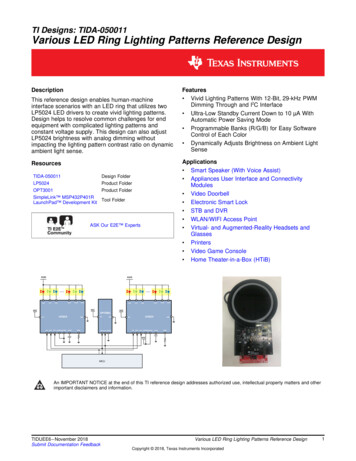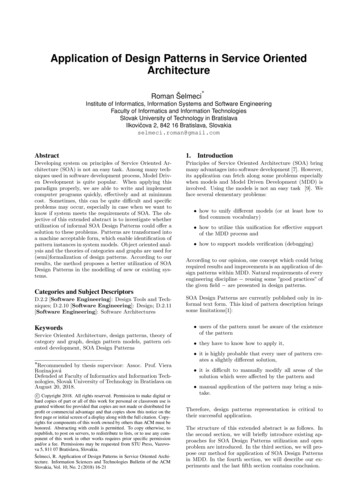
Transcription
Application of Design Patterns in Service OrientedArchitecture Roman ŠelmeciInstitute of Informatics, Information Systems and Software EngineeringFaculty of Informatics and Information TechnologiesSlovak University of Technology in BratislavaIlkovičova 2, 842 16 Bratislava, g system on principles of Service Oriented Architecture (SOA) is not an easy task. Among many techniques used in software development process, Model Driven Development is quite popular. When applying thisparadigm properly, we are able to write and implementcomputer programs quickly, effectively and at minimumcost. Sometimes, this can be quite difficult and specificproblems may occur, especially in case when we want toknow if system meets the requirements of SOA. The objective of this extended abstract is to investigate whetherutilization of informal SOA Design Patterns could offer asolution to these problems. Patterns are transformed intoa machine acceptable form, which enable identification ofpattern instances in system models. Object oriented analysis and the theories of categories and graphs are used for(semi)formalization of design patterns. According to ourresults, the method proposes a better utilization of SOADesign Patterns in the modelling of new or existing systems.Principles of Service Oriented Architecture (SOA) bringmany advantages into software development [7]. However,its application can fetch along some problems especiallywhen models and Model Driven Development (MDD) isinvolved. Using the models is not an easy task [9]. Weface several elementary problems:Introduction how to unify different models (or at least how tofind common vocabulary) how to utilize this unification for effective supportof the MDD process and how to support models verification (debugging)According to our opinion, one concept which could bringrequired results and improvements is an application of design patterns within MDD. Natural requirements of everyengineering discipline reusing some ”good practices” ofthe given field are presented in design patterns.Categories and Subject DescriptorsD.2.2 [Software Engineering]: Design Tools and Techniques; D.2.10 [Software Engineering]: Design; D.2.11[Software Engineering]: Software ArchitecturesKeywordsService Oriented Architecture, design patterns, theory ofcategory and graph, design pattern models, pattern oriented development, SOA Design Patterns Recommended by thesis supervisor: Assoc. Prof. VieraRozinajováDefended at Faculty of Informatics and Information Technologies, Slovak University of Technology in Bratislava onAugust 20, 2018.c Copyright 2018. All rights reserved. Permission to make digital orhard copies of part or all of this work for personal or classroom use isgranted without fee provided that copies are not made or distributed forprofit or commercial advantage and that copies show this notice on thefirst page or initial screen of a display along with the full citation. Copyrights for components of this work owned by others than ACM must behonored. Abstracting with credit is permitted. To copy otherwise, torepublish, to post on servers, to redistribute to lists, or to use any component of this work in other works requires prior specific permissionand/or a fee. Permissions may be requested from STU Press, Vazovova 5, 811 07 Bratislava, Slovakia.Šelmeci, R. Application of Design Patterns in Service Oriented Architecture. Information Sciences and Technologies Bulletin of the ACMSlovakia, Vol. 10, No. 2 (2018) 16-21SOA Design Patterns are currently published only in informal text form. This kind of pattern description bringssome limitations[1]: users of the pattern must be aware of the existenceof the pattern they have to know how to apply it, it is highly probable that every user of pattern creates a slightly different solution, it is difficult to manually modify all areas of thesolution which were affected by the pattern and manual application of the pattern may bring a mistake.Therefore, design patterns representation is critical totheir successful application.The structure of this extended abstract is as follows. Inthe second section, we will briefly introduce existing approaches for SOA Design Patterns utilization and openproblem are introduced. In the third section, we will propose our method for application of SOA Design Patternsin MDD. In the fourth section, we will describe our experiments and the last fifth section contains conclusion.
Information Sciences and Technologies Bulletin of the ACM Slovakia, Vol. 10, No. 2 (2018) 16-212.BackgroundExisting research sources offer only few existing approaches for application of SOA Design Patterns. Authors in [16,14, 15] propose a method for formalization of limitedpatterns group with application of SoaML and Event-B.SoaML is used for (semi)formal representation of patterns in models and Event-B is used as a method for verification if pattern in models are correctly used. Thisapproach enables modeling structural and behavioral aspects of patterns. Another approach uses ontology [12].Authors transform patterns into ontology which suggestspattern according to user requirements in form of questions and corresponding answers. Both of these approaches has some limitations. The first one has limited application only for message oriented patterns and the secondone does not allow to verify system models but only suggests patterns according to user requirements. In addition, user has to apply pattern by himself/herself. Thelast approach [4] declares representation of SOA DesignPatterns only by Service Component Architecture (SCA)standards and patterns are formalized by utilization oftheir Domain Specific Language (DSL) for ”rules cards”based on SCA metrics. A rule describes a metric, a relationship, or a combination of other rules using set ofcustom operators. This approach supports identificationof pattern variants in SCA model but does not supportmodeling with pattern involved.SOA Design Patterns are influenced by patterns from other areas. Therefore, we studied also several approachesfrom object oriented paradigm, service iteration patternsand enterprise integration. After having done an analysisof different methods, we came to the following conclusion:Approaches for the object oriented design patterns aremostly focused on generating code in specific programming language. SOA Design Patterns often appear in ahigher abstract form, which mostly can not be directlyconverted into executable programming language code.Petri’s or Open nets used for Service interaction patternsare closely linked to a concept of services communicatingthrough messages and connected channels. SOA DesignPatterns publication contains many categories which arenot concerned with messages, these approaches are notsuitable for all of them.SOA Design Pattern are published in informal text way.Therefore, if we want to reach better utilization of com-17puters with its manipulation, we need to define at leastsome (semi)formal representation of patterns. If we wouldlike to support modelling of architecture in SOA basedsystems, one of the most important sections of design pattern definition is a structure. Our main goal is to proposean approach for better application of SOA Design Patterns [7].We set following requirements for new method: Propose a transformation process of SOA DesignPatterns from informal text representation into newcomputer acceptable form. Include support for representation and identificationof SOA Design Patterns which enable its applicationduring modeling of system. Include support for modification suggestions of system’s model according to rules from pattern application in order to remove well known bad designstructures. Enable evaluation of design quality according toidentified design patters in models.A language independence in modeling language and alsosupporting tool is main criterion for method implementation.3.Our Method for SOA Design Patterns ApplicationRigorous and precise structural modeling of SOA designpatterns could be reached by a graph theory and categorytheory.Graphs, as bases for structural modeling of patterns, support quite easily patterns transformation to required model notation. Graph algorithms and databases, which couldbring flexibility and tool support to application of patterns, can be also used. This utilization of graphs alsosupports describing (nested) variable sub-models as wellas inter-pattern synchronization across several diagramsor models synchronization [11]. Graph grammar could bealso used for (semi)automatic transformation of models.Our approach is based on approaches from [2, 6] and object oriented analysis. It defines common vocabulary forannotating system models with extra information and enables reusing of ”good practices” from patterns in development.(Fig. 1).Figure 1: Overview of proposed approach. Pattern participants and relationships are used for annotatingmodels on different levels of abstraction. This enables identification of pattern instances and eventuallycorrectness checking of whole design with patterns.
18Šelmeci, R.: Application of Design Patterns in Service Oriented ArchitectureDesign Pattern ProfileDesign PatternProblemSolutionContextImpactPattern VocabularyApplicationPattern StructurePeopleCan readPattern VariantsPattern semi-formalizationTextSemi-formalCan readImpact FactorsAnalyticPattern VocabularyMeta-ModelCASE UtilityApplicationGrammarFigure 2: Overview of transformation process.The authors in [2] propose a language-independent approach for visual patterns modeling which could be usedin MDD. They applied their approach to a formalizationof object-oriented patterns and provide simple examplesof how to apply their approach to other kinds of designpatterns like work-flow patterns and enterprise integration patterns (EIP). However, the authors did not applytheir approach to SOA Design Patterns [7]. Authors alsodo not propose method for identification of pattern in existing system models and method for modification of themodel according to patterns.First of all, we defined transformation process (Fig. 2) inorder to represent pattern in more computer acceptableform. Input for the process is an informal textual designpattern specification and its output is a pattern profilesuitable for computer processing.The descriptions of an individual process steps follow:1. Identification of pattern participants and theirs roleswith object oriented analysis of the informal textualpattern specification.2. Definition of pattern vocabulary and structure.3. Identification of possible pattern variants.4. Definition of new pattern profile with sections forproblem and solution variants, pattern context, pattern impacts and pattern application.Pattern as well as its instance can have many variations([13]). We need to find out how we could describe thesevariations as precisely as possible. Authors in [2] propose so-called variable pattern for purpose of capturingvariation of design pattern instances. Individual patternvariants are modeled according to structural constrains Inventory Inventoryis stored inis standardized incontainsfrom created pattern vocabulary. Fig. 3 shows an example of one variant for the Canonical Protocol Pattern.Figure contains variant for situation when all services ininventory use standardized communication protocol.Some patterns like Enterprise Inventory pattern can beapplied only in specific context - within small to medium size organization with legacy systems and sufficientresources. All pattern variants of this pattern must conform this conditions. However, if we add these conditionsdirectly into each diagram, diagram could be unreadableand also could contains cross-cutting concerns. Patterncontext is defined as extra diagram and synchronized withindividuals variants.Pattern variant has unique impacts on the design. If designer knows these impacts, he/she can choose design withrequired characteristic and quality. Impact can influencesome of participants in instance of pattern variant (or onlysubset of them) in specific time and duration.The application of pattern is defined as a transformationprocess from problem variable pattern into solution variable pattern with utilization of typed attributed graphtransformation system (GTS) and graph grammar [6].Now, we have method to describe SOA design patterns inmore (semi)formal representation. However, if we wantto reach a better application of the SOA design patternsin MDD, we need to find solutions for another problems.The first problem is concerned with a format variability ofthe system models. Each stakeholder in process of SOAbased system development could use different notificationfor description of his/her parts. Transformation of SOADesign pattern into computer acceptable form makes itpossible to use a common vocabulary for annotation ofobjects in different models which results in easier understanding of these labels. Service Serviceusesis used by Communication Protocol CommunicationProtocolstandardizesFigure 3: Example of Canonical Protocol Pattern variant definition.
Information Sciences and Technologies Bulletin of the ACM Slovakia, Vol. 10, No. 2 (2018) 16-21If we combine all pattern vocabularies from all transformed patterns, the result is meta-model for modeling allparts of SOA based system in which elements from transformed patterns are participating (and pattern instancescan be identified). Our meta-model also allows us to checkstructural correctness of the system or to create graphgrammar that conforms to the input meta-model ([10]).Utilization of meta-model enables semi-automatic modification of the model by applying transformation rulesdefined in patterns profiles. Pattern are added to the existing models with utilization of pattern-annotated model [3].The second problem is how to detect pattern variant insystem design to find any possible problems in it. Moreover, elements forming design patterns need to be located,interpreted and connected in the right manner. How todo it?Authors in [2] do not offer algorithm for detection of design pattern instances because they manually select desired pattern and create its instance during modelling ofthe system. They only propose algorithm for pattern satisfaction. It performs a depth-first traversal of the Emptree, counting the occurrences of the variable parts alongthe way and finally check if these occurrences satisfy thegiven constraint of variable parts. Some steps of this algorithm rely on graph pattern matching. Expansion set isa core part in the process of a pattern satisfaction. Modelsatisfies a variable pattern in case some pattern expansionis found in this model.Unlike the approach described in the [2, 3], we do notuse pattern instances during designing phase, instead weassume that SOA patterns originate from SOA principles [7]. Therefore, we use several system models that areannotated with patterns participants roles and then welook for possible pattern instances. We offer to apply setsof paths for description of variable patterns and unification of a detected path in the pattern-annotated modelfor detection of variable pattern instances.In contrast to original approach in [2], designer with ourmethod can start with modeling the SOA based systemwithout any knowledge about all existing patterns. Designer only has to use pattern participants vocabulary.The correctness of the system is verified in (semi)automatic manner with utilization of a knowledge base createdfrom formalized SOA Design Patterns. This results intothe benefit that less experienced designer without knowledge about all design patterns could be able to designthe system and reach almost the same design quality as adesigner who knows all patterns.4.Experiments and EvaluationWe set up testing environment and conducted several experiments which were focused on different areas:4.1Pattern Transformation to Proposed Profile andCreation of a Knowledge Base of PatternsWe experimented with the following SOA design patterns:Canonical Protocol, Canonical Schema, Domain Inventory, Enterprise Inventory, Entity Abstraction, Logic Centralization, Policy Centralization, Process Abstraction,Process Centralization, Rules Centralization, Service Layer, Service Normalization, Schema Centralization, and U-19tility Abstraction, Redundant implementation. We transformed all these patterns and stored them in the knowledge base prototype. All of these patterns were be ableto transform into new profiles.4.2Definition of Domain Specific Language for Annotation of SOA Solution with Pattern VocabularyOur approach is language independent and can be implemented in different forms. We used it in models withutilization of UML stereotypes but also for experimentingand testing we created a DSL named soa:Pt for creatingpattern annotated models. In our case, language is focused on modelling of SOA based system domain. As aninternal DSL is soa:Pt built on top of hosting languageClojure 1 . Semantic model [8] of this language is a metamodel created by combination of all individual patternmeta-models. Cardinality between domain objects is notused because it is defined in individual pattern variants.Each time a new pattern is added to meta-model, new language structure is also added. soa:Pt controls if allowedrelationships used among domain objects (where inherited relationships are included) fulfills language semanticmodel.4.3Identification and Reconstruction of PatternVariant Instance with Utilization of GraphDatabaseOur aim is not to define a new algorithm for detection ofpath in attributed graph, but to use already existing solution for detection of path in an attributed graph, thereforewe use Neo4j2 - graph database which offers declarativelanguage Cypher for path definition and detection. In order to initialize database with data, soa:Pt statements aretranslated into Neoj4 Cypher query.4.4Use Cases TestingWe had two types of use case tests. Firstly, we defined several tests for each pattern inspired by case studies from [7].These tests simulate adequate environment in which pattern variants have to be identified and applied. The second type of testing was performed on a real project. Thisproject is relatively new and its development started fromscratch. Service Oriented Architecture principles and micro-services are first-class citizens in this project. Theproject was developed in the organization, which startedup just a short time before its beginning. There is nolegacy software, its culture is very flexible and development is based on agile methodology. Core developmentteam consists of 5 people. In the first few months of development, the focus was given to prototyping and noarchitectural documentations was created. Services werecreated taking into consideration the principles of SOA,but without knowledge of SOA Design Pattern (most developers have a little knowledge about them). After sometime we started to create models and documentation ofcreated services in UML diagrams and ArchiMate. Thesediagrams were taken and rewritten into soa:Pt. One ofsystem requirements was:1Clojure, http://clojure.org/Neo4j.org, neo4j: World’s Leading Graph Database,http://www.neo4j.org/2
20Šelmeci, R.: Application of Design Patterns in Service Oriented ArchitecturePrivileges ManagerTicketManagersFilter privileged dataRuntime for PrivilegeManagerWork ReportsManagerPrivileges ManagerProduction ServerPrivilege ManagerDocker ContainerElementsManagerFigure 4: One instance of Privilege Manager is used by several services. Service Filter privilegeddatarunscomminicates withcomminicates withruns in Service Ticket Managercomminicates with Service Work Report Managercomminicates with Service Element Manager Service Instance Privileges Managercommunicates withruns Service Filter privilegeddata Service Service Facade Privileges Manager Loadbalancercomminicates withis delegeted fromis represented byrepresentsruns in Service Instance Privileges Manager delegates toruns in Service Instance Privilege Manager 2 delegates tocomminicates with Service Ticket Manager Service comminicates with Work Report Managercomminicates with Service Element Managercommunicates withcommunicates withcommunicates withFigure 5: Redundant Implementation example. Top side shows identified problem and bottom sideproposed solution (red color represent remove modification and green add).Business requires to manage user access to element dataaccording to his/her privileges. Data Privilege Managerwere developed for this purpose. This agnostic serviceis used in several service compositions (etc. with TicketManager, Work Reports Manager and Elements Manager). Only one instance of Data filtering service was deployed on production servers (Fig. 4).How do we know that this design fulfills all requirements[5] for manageable, efficient and robust system based onSOA principles? We ran our pattern detection method onsystem models and i.e. we were able to identified this:Problem was identified in services for managing user privileges and filtering element data. Data Filtering service isused in several service compositions, but only one serviceinstance was deployed on production services. Problempattern variant for Redundant Implementation was identified in actual design. According to the identified designpattern variant, that service is a single failure point forany other services. New design (Fig. 5) was created whereDF Load-balancer acts as a service facade for additionalinstances of service. According to design profile we knowthat this new design brings new impacts of complexity ofinfrastructure and increases requirements on service government.We were capable to remove several identified problemsfrom system with utilization of pattern application rulesand improve its design quality.4.5EvaluationAccording to these tests, we are able to identify variantsof SOA Design Patterns in existing models only with application of pattern vocabulary, knowledge base createdduring process of (semi)formalization of SOA design patterns and graph database which contains data from thesemodels. In addition, we are able to suggest design modification which can remove well known problems describedin SOA design patterns. Moreover, design quality can becalculated from impacts of identified pattern variants insystem.
Information Sciences and Technologies Bulletin of the ACM Slovakia, Vol. 10, No. 2 (2018) 16-215.ConclusionIn this extended abstract we have presented a new approach for better application of SOA Design Patterns inthe process of SOA solutions modelling. Transformationof existing informal pattern definitions into computer acceptable form with application of category theories andgraph theories have been presented. Our design pattern profile was also presented. Pattern profile contains information about impacts of individuals pattern variant, which can be in the future used for calculating overall score of system quality according to identified pattern variants. Application of design patterns with utilization of graph grammar and transformation system arealso parts of the pattern profile. Graph grammar supports semi-automatic calculation of alternative solutionfrom which identified instances of pattern problems areremoved. Transformation of several SOA Design Patterns lets us to create knowledge base of patterns and definevocabulary which can be used in annotating of SOA solution models. On the top of this vocabulary, we createdsimple DSL which has a support for syntax verificationof models and unify system model into graph representation. This unified representation of the whole systemdesign is used for searching instances of pattern variantsstored in knowledge base. We have introduced a new wayof description and detection of pattern variants with application of graph paths and existing graph database language. And finally, we experimented with several SOAdesign patterns in synthetic use cases as well as in thereal project. Application on the real project leads to identified problems areas of creating system and permitsus to fix it. According to these results we believe that wefulfill our main goals in dissertation thesis.Acknowledgements. The work reported here was partially supported by the Slovak Research and DevelopmentAgency under the contract No. APVV-0208-10; the Scientific Grant Agency of Slovak Republic, grant No. VG1/1221/12; Operational Programme, ITMS 26240220039,co-funded by the ERDF and STU Grant scheme for Support of Young Researchers.References[1] L. Ackerman and C. Gonzalez. Patterns-Based Engineering:Successfully Delivering Solutions Via Patterns. Addison-WesleyProfessional, 2010.[2] P. Bottoni, E. Guerra, and J. de Lara. A language-independent andformal approach to pattern-based modelling with support forcomposition and analysis. Information and Software Technology,52(8):821–844, Aug. 2010.[3] P. Bottoni, E. Guerra, and J. Lara. Formal Foundation forPattern-Based Modelling. In Proceedings of the 12th InternationalConference on Fundamental Approaches to SoftwareEngineering: Held as Part of the Joint European Conferences onTheory and Practice of Software, ETAPS 2009, FASE ’09, pages278–293, Berlin, Heidelberg, 2009. Springer-Verlag.[4] A. Demange, N. Moha, and G. Tremblay. Detection of soapatterns. In S. Basu, C. Pautasso, L. Zhang, and X. Fu, editors,Service-Oriented Computing, pages 114–130, Berlin, Heidelberg,2013. Springer Berlin Heidelberg.21[5] J. Dick, E. Hull, and K. Jackson. System Modelling forRequirements Engineering, pages 57–92. Springer InternationalPublishing, Cham, 2017.[6] H. Ehrig, K. Ehrig, U. Prange, and G. Taentzer. Fundamentals ofAlgebraic Graph Transformation (Monographs in TheoreticalComputer Science. An EATCS Series). Springer-Verlag New York,Inc., Secaucus, NJ, USA, 2006.[7] T. Erl. SOA Design Patterns. Prentice Hall PTR, 2009.[8] M. Fowler. Domain Specific Languages. Addison-WesleyProfessional, 1st edition, 2010.[9] R. France, B. Rumpe, and M. Schindler. Why it is so hard to usemodels in software development: observations. Software &Systems Modeling, Oct. 2013.[10] L. Fürst, M. Mernik, and V. Mahnič. Converting metamodels tograph grammars: doing without advanced graph grammarfeatures. Software & Systems Modeling, Sept. 2013.[11] F. Hermann, H. Ehrig, F. Orejas, K. Czarnecki, Z. Diskin,Y. Xiong, S. Gottmann, and T. Engel. Model synchronizationbased on triple graph grammars: correctness, completeness andinvertibility. Software & Systems Modeling, Jan. 2013.[12] L. Liu, P. Miao, L. Pavlic, M. Hericko, and R. Zhang. Anontology-based advisement approach for soa design patterns. InL. Uden, L. S. Wang, J. M. Corchado Rodríguez, H.-C. Yang, andI.-H. Ting, editors, The 8th International Conference onKnowledge Management in Organizations, pages 73–84,Dordrecht, 2014. Springer Netherlands.[13] D. Riehle. Lessons Learned from Using Design Patterns inIndustry Projects. In J. Noble, R. Johnson, P. Avgeriou,N. Harrison, and U. Zdun, editors, Transactions on PatternLanguages of Programming II, volume 6510 of Lecture Notes inComputer Science, pages 1–15. Springer Berlin / Heidelberg,2011.[14] I. Tounsi, M. Hadj Kacem, and A. Hadj Kacem. Building correctby construction soa design patterns: Modeling and refinement. InK. Drira, editor, Software Architecture, pages 33–44, Berlin,Heidelberg, 2013. Springer Berlin Heidelberg.[15] I. Tounsi, M. H. Kacem, A. H. Kacem, and K. Drira.Transformation of compound soa design patterns. ProcediaComputer Science, 109:408 – 415, 2017. 8th InternationalConference on Ambient Systems, Networks and Technologies,ANT-2017 and the 7th International Conference on SustainableEnergy Information Technology, SEIT 2017, 16-19 May 2017,Madeira, Portugal.[16] I. Tounsi, M. H. Kacem, A. H. Kacem, K. Drira, andE. Mezghani. Towards an approach for modeling and formalizingsoa design patterns with event-b. In Proceedings of the 28thAnnual ACM Symposium on Applied Computing, SAC ’13, pages1937–1938, New York, NY, USA, 2013. ACM.Selected Papers by the AuthorR. Šelmeci, Rozinajová. One approach to partial formalization of SOAdesign patterns using production rules In FEDCSIS - Proc. of theFederated Conf. on Computer Science and Information Systems,pages 1381–1384, Wroclaw, Poland, 2018. Piscatawey : IEEE.R. Šelmeci, Rozinajová. SOA Design Patterns - can they improve theprocess of Model Driven Development? In SCC 2013Proceedings of the IEEE 10th Int. Conf. on Services Computing,pages 753–754, Santa Clara, California, 2013. Los Alamitos :IEEE Computer Society.R. Šelmeci, Rozinajová. Towards More Effective Service ModellingUtilizing SOA Design Patterns. In Int. J. of Web ServicesResearch (IJWSR), [in review].
Service Oriented Architecture, design patterns, theory of category and graph, design pattern models, pattern ori-ented development, SOA Design Patterns Recommended by thesis supervisor: Assoc. Prof. Viera Rozinajov a Defended at Faculty of Informatics and Information Tech-nologies, Slovak U
